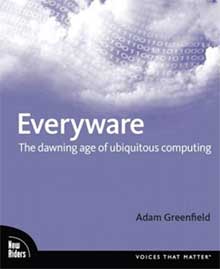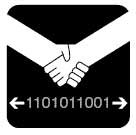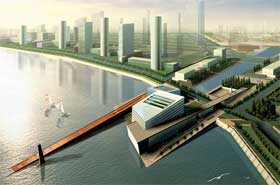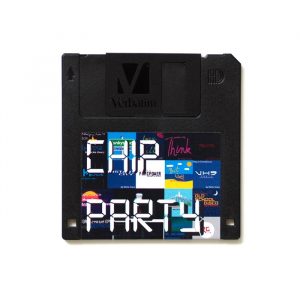 I first met writer and critical futurist Adam Greenfield a couple of years ago in Berlin where he both scared and fascinated us with a talk about, between others, the global oil production. Last year i heard him talk on two very different occasions, to two very different types of audience. The first time it was at conflux, an art festival about psychogeography. The second time was at Ci’num, a conference that gathers what the organizers calls the “shapers of the future.” Each time his talk met with the same success.
I first met writer and critical futurist Adam Greenfield a couple of years ago in Berlin where he both scared and fascinated us with a talk about, between others, the global oil production. Last year i heard him talk on two very different occasions, to two very different types of audience. The first time it was at conflux, an art festival about psychogeography. The second time was at Ci’num, a conference that gathers what the organizers calls the “shapers of the future.” Each time his talk met with the same success.
His latest book, Everyware: The Dawning Age of Ubiquitous Computing tells about what we can read in all the tech mags: computing without computers, everywhere, all the time and whithout us noticing it. For the first time however, someone who has observed the “ubicomp’d” life on several continents has put into a social, spatial, design and human context the consequences of this recent technology. I should also add that the book translates the working, meanings and implications of ubicomp into a very accessible language.
I still had a series of questions for Adam though. To be sure that i wouldn’t leave too many stones unturned, i asked Nicolas Nova to come to my rescue. Well… that’s the best excuse i could find to convince the guy who writes the only blog i would bring to a desert island to come and use wmmna space. Nicolas and i have both published the interview yet you’ll have to read the both of them to get the full picture: i posted some of his questions but not all of them and god knows what he’s done with mine ;-)
RD: I was used to reading about ubiquitous computing, pervasive computing, tangible computing, etc. So why Everyware? What does the concept brings that the other terms do not cover?
AG: I like to think it brings a certain accessibility. The book is, in large part, intended to help non-technically-oriented people wrap their heads around this domain – to grasp what the irruption of information processing into everyday life implies for them. And something of which my work in user experience had already convinced me is that offering people a single, well-chosen word will frequently allow the insights and recognitions they’ve already had to crystallize around it.
The problem with all those other terms, to my mind, is twofold. Firstly, each is a mouthful, there’s nothing euphonious about them. But more seriously, each only describes a single facet or aspect of the situation at hand. I think there are important commonalities – deeper resonances – between the ways people experience all of these non- or post-PC interaction modalities.
A multi-touch interface may be offered on an otherwise ordinary desktop device, the human interface with an embedded sensor grid may be entirely conventional, a touchless transit pass may seem to have little in common with an ambient information display, but to my mind they’re all symptomatic of an underlying unity: one having to do with the disappearance of obviously technical paraphernalia beneath the threshold of perception. It’s that conceptual unity that people will be experiencing, and it’s that which I had hoped to capture with the word “everyware.”
 NN: To me, Everyware sounds like a more evocative and user-centered metaphor, that expresses an alternative vision to terms like UC,\TC, less defined by laboratories and rather by a designer’s view. Do you agree with this intrepretation?
NN: To me, Everyware sounds like a more evocative and user-centered metaphor, that expresses an alternative vision to terms like UC,\TC, less defined by laboratories and rather by a designer’s view. Do you agree with this intrepretation?
AG: That’s certainly pretty gratifying if that’s what you’ve gotten from it, yes. Language is also a domain of user experience. Shouldn’t the words we use to describe a tool be as carefully crafted as the tool itself?
RD: Which type of readers did you have in mind when you wrote the book? The engineer? The man on the street who has some vague interest in what tomorrow will bring? Someone in between those two?
AG: The two primary audiences I had in mind were, on the one hand, the people who will be designing interactions with ubiquitous systems, and on the other the much larger group of smart generalists whose lives will be in some way affected by the deployment of these technologies, and want to better understand them.
Obviously these two groups of people are going to want different things from a book on the subject. The great challenge of writing Everyware was in trying to ensure that it’d be rigorous enough to satisfy the former, but accessible enough to reach the latter.
NN: When I’ve read your book, I was wondering why you haven’t described, or discussed the ideas and concepts raised by art projects about, those questions. I know you cannot refer to everything but…since you’re well versed into that domain… Was there a reason for that?
AG: Not referring to art projects was an explicit decision, based in part on my desire to limit the discussion to ways in which information processing would be showing up in everyday life. And almost by definition, however trenchant or clever the point of view embedded in them may be, art objects are simply not going to be relevant to that consideration.
With occasional exceptions – Natalie Jeremijenko‘s Dangling String comes to mind – there’s a clearer evolutionary pathway between even the more abstract exercises in corporate “visioning” and everyday experience than there is between art objects and that experience. So that’s where I thought it would make more sense to focus, in a context where I did have very real limits on what I could get into in any depth. As it is, the book is so close to its absolute limit on page count that the publishers wouldn’t let me include a bibliography.
NN: It’s been a while that the book has been released. After those few months, when you look back and think about the reactions and the debate it had fostered, what are the main issues that emerged? Where there unexpected discussions? If you had to add new parts in that book, what would it be about?
AG: Oh, god. I’d probably write a completely different book now. It’s not so much a question of new material, although there’s inevitably a wealth of more up-to-date information that we could profitably discuss, as what I’d want to leave out. The thesis on mash-ups, for example, which is the surviving third of a much longer argument about the decentralization of technological development, and doesn’t make all that much sense in its shorter version.
At that, I guess the thing that’s surprised me most in terms of the response is how consistently readers have said, essentially, “OK, you’ve convinced me that this stuff is going to happen, is happening. You don’t need all this material in here laying out this argument in detail. I buy the premise.” So what I’m hearing is that I probably could have trimmed out long stretches of Section 6, parts of which are the most technical in the book, the most rapidly obsolescing and the weakest in terms of their contribution to the overall argument.
As to that argument, it’s gotten a warm response from people in the field; in particular, the reception I got when I presented on the Everyware material at PARC itself was extremely gratifying. There have been exceptions, of course. Anne Galloway has expressed very clearly her distrust of all a priori design guidelines, or of anything that tends to universalize or genericize, and to some degree I think that’s fair comment; Victoria Bellotti at PARC, if I understood her correctly, seemed to feel that the sorts of graphic identifiers for information gathering activities called for in the book would likely be dangerously reductive or misleadingly incomplete, worse than no notification at all.
And as to the reactions of those not in the field? I still can’t tell. Even after ten months in the wild, I don’t think it’s found its audience.
RD: Adam, you’re a designer, why did you feel that the field of everyware couldn’t be left in the sole hands of ubicomp specialists? What does the reflection of a designer bring to the discourse?
 AG: It may simply be a reflection of the stage this particular class of technologies is at in terms of mass adoption, but the persistent sense I’ve had when I consider the ubiquitous systems I’ve seen over the last few years is one of “design by engineers, for engineers.” That is, important specifications of these systems, their functionality and feature sets are oriented toward the predilections, interests and abilities of the highly technically skilled.
AG: It may simply be a reflection of the stage this particular class of technologies is at in terms of mass adoption, but the persistent sense I’ve had when I consider the ubiquitous systems I’ve seen over the last few years is one of “design by engineers, for engineers.” That is, important specifications of these systems, their functionality and feature sets are oriented toward the predilections, interests and abilities of the highly technically skilled.
And we get into trouble here, because by definition the broadest possible cohort of users are exposed to everyware: not just people who like and are comfortable around technology, even to the extent that a mobile phone is “technology,” but to all intents and purposes, everyone in contemporary developed-world society.
If ubiquitous systems, products, and services are developed in the absence of careful, sensitive interaction design they fail. And they fail in a way that poses particular challenges and risks to the user’s sense of calm and equanimity, because by and large the interaction landscape of everyday life is very robust, very well-assimilated. We simply don’t expect the constituents of everyday experience to crash, lock up, or perform perversely or incoherently the way digital information technologies manifestly do.
There’s also the question of the terrain on which these dramas will play out, the stage we understand as ordinary life. I saw a comment recently, in a book on pictograph design, that summed up the kind of perceptual imagination necessary to good ubiquitous design: the authors were discussing the specifications of the familiar universal emergency exit sign, and their point was that these had to be large and graphically “chunky,” because recreational drug and alcohol use frequently impair perception.
And they had a blurry, indistinct picture of an exit sign right there on the page, and you maybe thought back to one or two occasions on which you might have been so impaired yourself, for whatever reason, and you saw exactly what they meant. That struck me as a very good – very wise and empirical – understanding of the real-world context for design, and that’s exactly what I think good interaction designers can bring to the conversation.
So. Someone with a commitment to the human being at the focus of these technologies, who’s been trained to weigh that person’s prerogatives heavily in the design of transactions, who has the experience to recognize and account for not merely this single system but the entire context in which it’s operating – that’s the person you want to include on your team if you expect your intervention to succeed. I can’t imagine why anybody serious about satisfying their users and customers would want it any other way.
NN: Since Everyware will pervades the environment, how will designers create means to make people aware of the presence of such systems? Or about the way they work and their potential dangers? Lots of people advocate for system transparency, what would that look like in an Everyware world?
AG: I think it has to be a defense in depth, as it were. You’ve got to simultaneously build into the system itself an appropriate accounting of its capabilities, ownership and extent of operation; devise external, graphic, and non-technical means to convey the same information to people who don’t have the technical wherewithal to avail themselves of it otherwise; and acculturate people to understand what’s technically possible and what they are likely to encounter in their world as we move forward.
And ideally, you do this all in such a way as to preserve the sense of “encalming as well as informing,” so that you’re not wrapping people up in a web of restrictions, or subjecting them to a continuous barrage of scary-sounding warnings. It’s clearly a nontrivial challenge – I mean, there are entire careers embedded in the preceding paragraph.
RD: I’d like to discuss the icons you designed to make the presence of ubiquitous computing more visible. Did you design them from scratch or did you find examples of icons that already existed and could be improved? How much, in general, can a designer rely on references from the past when dealing with ubicomp?
 AG: Well, of course there’s a rich precedent in the ISO symbol set, in the Olympic pictograms and so forth. And you’re familiar with Timo Arnall’s work on a “graphic language for touch,” which was a major touchstone for us. Beyond that, though, Nurri and I pretty much whipped them up ourselves. I think it was Andrew Otwell‘s wonderful suggestion to play off the stock expression “black box” for the icon “this object has imperceptible qualities.”
AG: Well, of course there’s a rich precedent in the ISO symbol set, in the Olympic pictograms and so forth. And you’re familiar with Timo Arnall’s work on a “graphic language for touch,” which was a major touchstone for us. Beyond that, though, Nurri and I pretty much whipped them up ourselves. I think it was Andrew Otwell‘s wonderful suggestion to play off the stock expression “black box” for the icon “this object has imperceptible qualities.”
I think in general that it’s very appropriate for the would-be designer of everyware to build on metaphors, correspondences and interaction-design conventions that have proven their worth in the past. Language, especially, is prone to a certain wonderful parsimoniousness: at least here in the States, we still speak in terms of people “with a golden Rolodex,” or a “little black book,” and it’s only recently that higher-tech metaphors like “having someone on speed-dial” or “pinging a friend” have appeared in daily use.
So why not work with that tendency? You just have to extraordinarily careful that in doing so, you’re not implying anything untrue about the system’s actual capabilities or functionality.
RD: You have travelled extensively and therefore can compare the way ubiquitous computing is being deployed in several parts of the world (US, Korea, Japan and Europe). Are we all welcoming the arrival of everyware or did you notice some resistance here and there?
AG: My perception has been that East Asian decision elites, particularly, are far more receptive to the value propositions implied by everyware than their counterparts in the West; Korea, Singapore and Japan, for example, all have ubiquitous initiatives at the national level.
Sometimes – and again, I need to emphasize that this is purely my own take – this extends to a general propensity in the society to accept the claims of technology advocates at face value, where North Americans and Western Europeans in the broad aggregate tend to be more cynical. But sometimes it does turn out that the average Korean, say, is far wiser, more nuanced in her understanding, and more critical of the ostensible benisons of ubiquitous informatics than Samsung and LG would like her to be.
In the long run, of course, the factors that govern whether or not a particular society embraces everyware are much more complicated than a simple binary pro- or anti- stance. We can see how everyware invokes and engages attitudes toward some really rich and only rarely made-explicit values – privacy, personal space and bodily distance, time, social status – and these are going to differ from region to region and from subculture to subculture even within a given society. So to my mind, it’s not so much a question of resistance, as to whether or not the designers of a particular ubiquitous system have invested the time and effort in understanding their target audience at a level of resolution sufficient to secure acceptance.
RD: New Songdo City is a “ubiquitous computing city” built from scratch in South Korea. How difficult do you think it would be/it is for existing cities to become totally everyware’d?
 AG: That’s a really good question, because for everyone living in some bootstrapped Pearl River Delta newtown there’ll be a hundred of us living in the “installed base” of existing, legacy cities. And presumably some of us will want to play too.
AG: That’s a really good question, because for everyone living in some bootstrapped Pearl River Delta newtown there’ll be a hundred of us living in the “installed base” of existing, legacy cities. And presumably some of us will want to play too.
And to tell you the truth, I don’t know. I simply don’t know the answer. I can’t quite tell yet whether everyware, in this regard, is more like the telegraph or the subway or the safety elevator or the internal combustion engine. I suppose that’s because it’s not one monolithic technology, but a cluster of associated ideas, only some of which may find adoption in any given milieu.
All of the above reshaped cities, but only some so colonized and overwrote the urban architectonic that it was essentially incapable of being reverted; it’s hard to imagine Los Angeles, for example, without its exoskeleton of structures and services dedicated to individual automobility. My best guess, at the moment, is that everyware won’t be like that. It’ll be bolt-on, depositional, incremental, retrofittable, plug-and-play, and synergistic. (Heh.)
I do think, though, that you’ll be able to tell – probably from orbit – the difference between an everyware city and one not so enhanced. I think it’ll stand out like a white phosphorus round in the large-scale patterns of human association and the habitual ways people move around and use the city.
RD: What are your next projects? Do you plan to keep on exploring the concept of everyware or would you rather turn your attention to other issues?
AG: Thanks for asking! I’d very much like to get beyond this kind of banal idea that there will be such-and-such a class of technologies, and focus on some particular domains of their application. As you’ve picked up on, my own personal interest is in the rough expanse between architecture and urbanism, and that’s where I’m spending most of my time just now, looking at both the urban architectonic and the nature of metropolitan experience as they evolve under the condition of ambient informatics.
This is something I’m exploring both in a class I’m co-teaching with area/code‘s Kevin Slavin, at NYU’s Interactive Telecommunications Program, and in my next book, which will be called The City Is Here For You To Use and which will hopefully come out sometime before the Arctic melts entirely. My sense is that there’s enough in there to keep me going for quite awhile.
Thanks Adam!







